With the first bunches of grapes now in the cellars for days practically all over Italy, waiting for the harvest to get into full swing in the most important territories, even Crea, with its Viticulture and Enology Research Center, is analyzing the first data and making its forecasts on the harvest that has just begun. Starting, as usual (and as Veneto Agricoltura also did a few days ago in its “2022 Harvest Forecast”), from the analysis of the weather trend, with Italy exceptionally united by a homogeneous trend from North to South. High temperatures, and particularly drought, characterized the Italian spring and summer. Despite the weather difficulties, 2022 crowned the Italian vineyard as resilient to climate change. The capacity of our territory has already been tested in the past, but never before have weather conditions been so adverse and hostile as in this year. For years, research, in synergy with the production world, has developed strategies to mitigate and adapt to climate change, according to Crea, allowing the wine supply chain not to find itself unprepared even in summers like the one we are experiencing.
From a phytosanitary point of view, the vintage looks good, as indicated by the data collected by Crea Viticoltura in Conegliano. The scarcity of rainfall has certainly facilitated the control of fungal diseases, also reducing the number of phytosanitary interventions: downy mildew is practically absent throughout Italy, only the presence of a few outbreaks of powdery mildew is detected but these are situations under control. There is also no trace of botrytis, not even in particularly susceptible cultivars with compact clusters. To be highlighted only the problem of flavescence dorée, which mainly affected the viticultural area of northern Italy, particularly Veneto, Emilia-Romagna, Piedmont and Lombardy.
In terms of production, 2022 will not be remembered as an abundant vintage, mainly due to vineyards not served by irrigation systems or rain catchment basins. In terms of quality, however, grapes have higher than normal sugar and coloring matter content, while acidity is constantly monitored to seize the ideal harvest time. The lack of day-night temperature range has affected quality in some areas for now, but these last few weeks may compensate, given the current weather pattern. The advance to 2021 is important and varies from 7 to 20 days, depending on the different viticultural areas.
For quantities, Friuli-Venezia Giulia and Veneto are expected to drop slightly over 2021 (-10% and -5%, respectively), due to the lack of rainfall and the inability to irrigate vineyards in some areas, hilly ones in particular. In Trentino-Alto Adige, production is increasing slightly, +5-6% over 2021, particularly for native red grape cultivars (Teroldego and Marzemino). Lombardy and Emilia-Romagna show a decrease in production, particularly for the Oltrepò Pavese area and the Romagna hills. Piedmont, on the other hand, has been less affected by the dramatic nature of the vintage where a reduction, compared to 2021, is expected by only a few percentage points. Two other leading Italian wine-growing regions, Tuscany and Apulia, have slightly higher production than 2021, but for different reasons: Tuscany was affected by a severe frost last year that compromised much of its production, and has recovered this year. In Apulia, bud fertility is good and above average, and in irrigated vineyards up to 10 percent more is expected. Finally, Sicily is the region that suffered the most this year, especially in non-irrigated vineyards, with declines of 5%-10% over 2021.
Copyright © 2000/2025
Contatti: info@winenews.it
Seguici anche su Twitter: @WineNewsIt
Seguici anche su Facebook: @winenewsit
Questo articolo è tratto dall'archivio di WineNews - Tutti i diritti riservati - Copyright © 2000/2025









































































































































































































